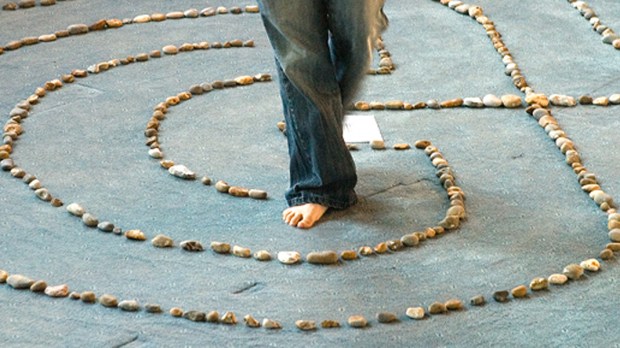It was winter of 2014 when I hopped on a plane to Arizona to visit one of my oldest and dearest friends, Sheri. The trip was celebratory—we were both reaching milestone birthdays—but it was also a chance to flee the frigid Chicago winter and recuperate after a crazy and exhausting year. In the previous 12 months, I had published a book and spent all of my free time trying to market it. I had also become a mother to a daughter of two-and-a-half, whom my husband and I were adopting through foster care. And I had done all of this while working a full-time job. I longed for warm, sunny weather and time with a dear friend.
Sheri and I spent a few nights at a fancy hotel, and then the next day she had to work so she dropped me off at the Franciscan Renewal Center in Scottsdale, where I could spend the day reading, writing, and praying.
I stopped at the front desk and looked at a map of the property. I noticed there was a labyrinth behind the main buildings, and so I headed there to find a quiet place to sit. From there, I could see the mountains. I sat on a bench and soaked in the sun and watched Gambel’s quail hopping along the brown earth and in and out of the desert scrub.
After an hour or so of feeling the sun on my face and listening to the silence, I decided to walk the labyrinth.
An ancient practice
No one really knows who created the first labyrinth, or why. The earliest labyrinth symbols are found in southern Europe and date to about 4,000 years ago. They were painted on fragments of pottery and carvings on rock surfaces.
One theory is that prehistoric labyrinths served as traps for malevolent spirits or as defined paths for ritual dances. But at some point, the meaning of the labyrinth changed to symbolize a path to God.
In the Middle Ages, walking a cathedral labyrinth was a substitute for a pilgrimage to Jerusalem. Not everyone could make the long and arduous journey to the Holy Land, so walking a labyrinth in a church was a devotional activity. Labyrinths were incorporated into the architecture of many churches—including the famous Cathedral of Our Lady of Chartres, a medieval Catholic cathedral in Chartres, France, constructed between 1194 and 1250. These days, labyrinths can be found all over the world in churches, parks, or even in the middle of cities.
You can get lost
That day in Arizona, I read the sign at the entrance of the rock-lined path to learn how to walk the labyrinth. It explained what I was to do: I could run or walk or dance. There was no one way to do the labyrinth; I could pray, think, or just listen.
I felt a bit silly. I checked a few times to see if there was anyone that might see me walking around in a circle being contemplative. But all I saw were desert jackrabbits hopping around, their tall ears perked for sounds of danger.
On the sign, it said several times: You cannot get lost. That was comforting, because I’m the kind of person who always wonders if I’m doing everything right, if I’m making the right decisions and following the right path. Knowing that I couldn’t get lost allowed me to focus on praying and meditating—and not on making a decision about what path to take.
So, I took the first step on the desert sand, feeling the warm sun on my head. I slowly walked the circular path, putting one foot in front of the other, and I noticed the smooth stones that marked my progress.
Labyrinths are sometimes referred to as “body prayers” or walking meditation. The entrance can be a place where you stop and reflect and pray for insight. As you move toward the center, you can let go of any worries and distractions, and then when you get to the “rosette,” or center, you can be open to God’s guidance.
Always leading you home
I continued walking, and as I arrived at the center of the labyrinth I discovered someone had made a cross with small stones. I stood there for several minutes, feeling the sand beneath my feet, a warm breeze on my face. The stress of the past year was melting away, and I prayed for guidance as I began a new chapter of my life. Then I slowly walked out of the labyrinth, following the same path that had led me in.
Since that trip to Arizona, I’ve tried to find labyrinths wherever I go. In Chicago, I discovered one at a convent about a half mile from my house. I even stumbled upon a labyrinth in the middle of the city—I often go there during my lunch hour to find spiritual reprieve from the often brutal world of work and it helps me find my spiritual center. On a trip to Sante Fe, my friend and I walked a labyrinth outside of the historic Cathedral Basilica of St. Francis of Assisi.
Every time I walk a labyrinth it’s a little different, but it always reminds me that my path might not be straight. There are times I might feel far from God, but I just need to put one foot in front of the other, listen for God’s voice, and eventually the path will lead me home.
Walk a labyrinth near you
With approximately 3,800 labyrinths in the United States, chances are you can probably find one close to where you live. Many labyrinths are in parks, on church properties, on college grounds, in monasteries, hospitals, or retreat centers and are free and open to the public. Here are a few to check out. You can also go to the Labyrinth Locator to find more in your town and state.

